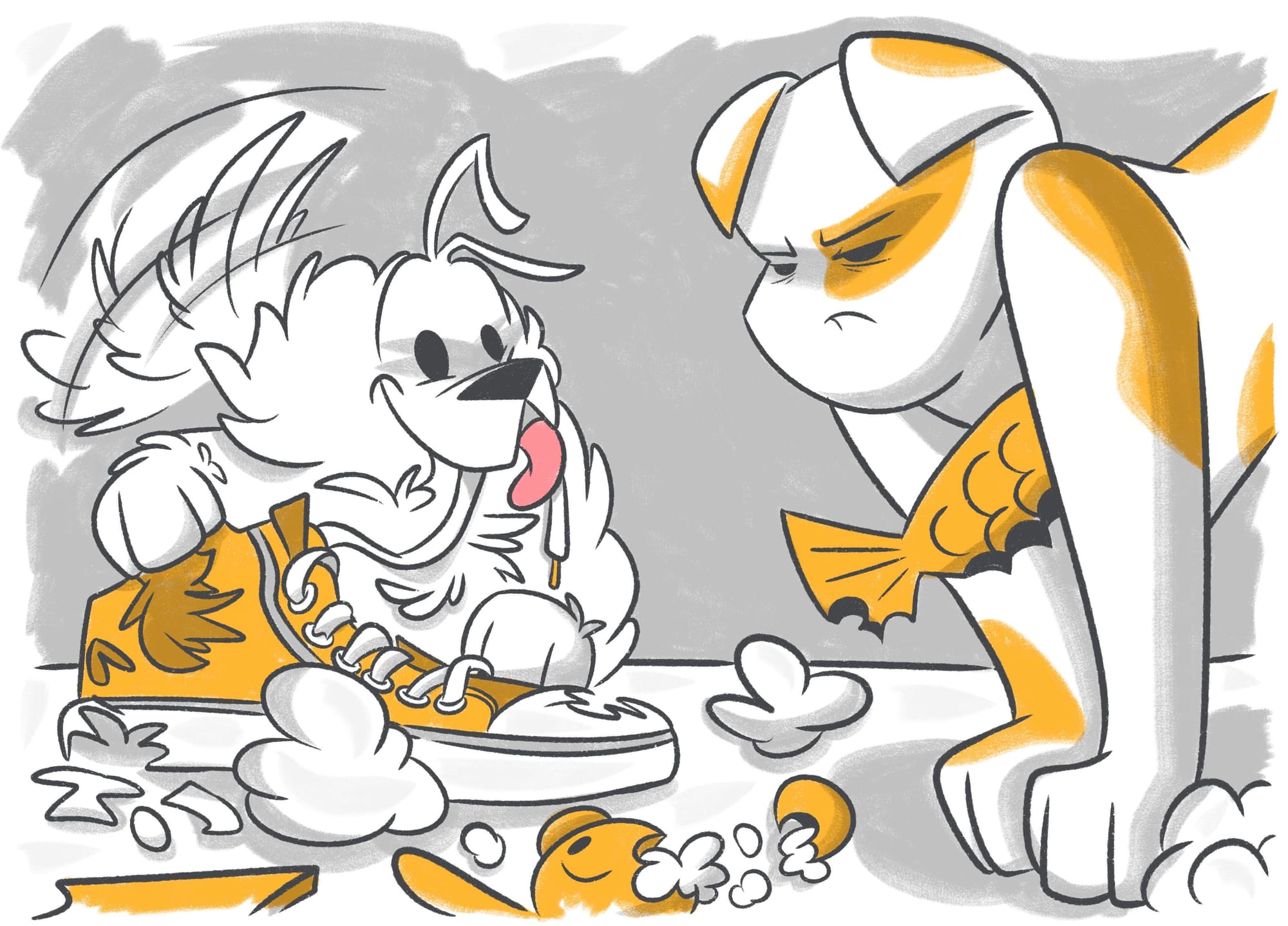Disciplining a puppy is essential to their development, but teaching them right from wrong can be achieved without punishment. Understanding the delicate balance between guidance and discipline is critical to fostering a healthy, happy relationship with your new furry friend without puppy problems.
In this article, we’ll explore effective, punishment-free methods to discipline your puppy. By focusing on positive reinforcement, consistency, and understanding your puppy’s needs, you can create a nurturing environment that encourages good behavior while strengthening the bond between you and your puppy.
Content:
- Five Steps to Discipline a Puppy
- How to Correct Bad Behavior in Puppies
- What to Do When Your Puppy Doesn’t Listen
- Managing Your Puppy’s Day While You’re at Work
- How to Train a Puppy
- FAQs
- Final Thoughts
Five Steps to Discipline a Puppy
Disciplining a puppy effectively without punishment involves a combination of patience, consistency, and positive reinforcement. Here are five steps to help guide your puppy’s behavior in a positive direction:
- Consistency is Key: Always be consistent with your commands and expectations. If jumping on the couch is off-limits, it should always be off-limits, regardless of the situation.
- Use Positive Reinforcement: Reward good behavior generously with treats, praise, or playtime. This teaches your puppy that good actions lead to positive outcomes.
- Redirect Bad Behavior: Instead of scolding, redirect your puppy's attention to a more appropriate activity. For example, if they are chewing on furniture, offer them an appropriate chew toy instead.
- Utilize Modern Technology: A Petcube camera can be invaluable in monitoring your puppy's behavior when you're not home. It allows you to observe, communicate, and even dispense treats remotely, reinforcing good behavior even when you’re away.
- Set Clear Boundaries: Teach your puppy the limits of their environment and what is expected of them. Use commands and guide them gently to understand these boundaries.
Combined with plenty of patience and understanding, these steps can help shape your puppy's behavior positively without punishment. Cesar Millan, a noted dog behaviorist, is known for his ability to transform even the most challenging dogs into happy, well-behaved companions through the use of his ‘trust, respect, and love’ philosophy.
His YouTube video on How to Train Your Puppy says, “As pet parents, we must create a safe, peaceful, and loving environment to connect, communicate, and have the most amazing relationship with them.”
How to Correct Bad Behavior in Puppies
Correcting bad behavior in puppies requires a gentle yet firm approach that focuses on teaching rather than punishing. Here's how you can start:
- Identify the Cause: Understand the trigger behind the bad behavior. Perhaps your pup is bored or anxious.
- Immediate Correction: When you catch your puppy in the act, offer an immediate but gentle correction by redirecting their behavior and using a firm 'no.'
- Reinforce Good Behavior: Always reinforce good behavior with praise or treats. This makes the excellent behavior more appealing than the bad.
- Be Patient and Consistent: Remember, training takes time. Consistency and patience are your best tools for correcting bad behavior without punishment.
The reality of having a puppy is that they will always seek out mischief. Your job as a pet parent is to ensure you're ready for any eventuality, including dreaded emergencies. Petcube’s Emergency Fund is the secret weapon every pet parent needs.
The Emergency Fund manages the financial burden of unexpected veterinary expenses brought on by an emergency. Not only does this ensure that your precious canine receives the necessary treatment without delay, but it also provides you with the peace of mind of knowing you're covered in an emergency.
The Emergency Fund by Petcube offers you up to $3,000 a year for emergency care. As a loyal blog reader, we're offering you an exclusive 27% discount when you sign up – follow the link!
What to Do When Your Puppy Doesn’t Listen
When your puppy doesn’t listen, it can be frustrating. However, it's essential to remain calm and patient. Here are some strategies to encourage compliance.
- Review Your Approach: Ensure your commands are clear and consistent. Puppies thrive on routine and clear expectations.
- Decrease Distractions: Try to minimize distractions around your puppy during training sessions. A quiet, calm environment helps them focus.
- Increase Bonding Time: Spend more quality time with your puppy. Stronger bonds can lead to better listening and compliance.
- Use Positive Reinforcement: Use treats, praise, and play as rewards for good behavior. This encourages your puppy to listen for positive outcomes.
- Seek Professional Help: If your puppy continues to ignore commands, consider seeking help from a professional trainer. Sometimes, an external perspective can make a big difference.
Understanding and patience are essential when disciplining your puppy without punishment. Every puppy is different, and finding what motivates them can take time.
Managing Your Puppy’s Day While You’re at Work
Leaving a puppy at home while you're at work can be challenging, but with careful planning (and some handy gadgets), it can be a smooth process. Here's what to do with your puppy while you’re at work:
- Create a Safe Space: Ensure your puppy has a comfortable, safe area with access to water, toys, and a bed.
- Establish a Routine: A consistent schedule for feeding, playtime, and bathroom breaks can help your puppy feel secure.
- Interactive Toys: Provide stimulating toys that keep them occupied and prevent boredom.
- Hire a Dog Walker: Hiring a dog walker for a midday break can provide your puppy with exercise and social interaction.
- Use a Petcube Camera: With a Petcube camera, you can monitor your puppy, communicate with them, and even dispense treats remotely. This helps maintain a connection with your puppy and monitor their well-being.
How to Train a Puppy
Training a puppy is a rewarding process that establishes a strong foundation for your lifelong relationship. Here are some handy tips on how to train a puppy to incorporate into your training regimen:
- Start with the Basic Commands: Begin with simple commands like “sit,” “stay,” ”come,” and “down.” Use treats and praise as rewards.
- Socialization: Expose your puppy to different people, animals, and environments to build confidence and good social behaviors.
- Keep Training Sessions Short: Puppies have short attention spans. Keep training sessions short and sweet to maintain their interest.
- Be Consistent: Consistency is crucial. Ensure everyone in the household is on the same page with commands and training techniques.
Incorporating these methods can make training a positive experience for you and your puppy. 'Dog Whisperer' Cesar Millan emphasizes the difference between socialization and play vs. exercise and the need for both. “Dog parks can be a fantastic way to socialize your dog, but owners need to understand that a dog park isn't exercise and isn't a substitute for walking. A visit to the dog park is fun - play time.”
FAQs
How long does it take to train a puppy?
The training duration varies depending on the puppy and the consistency of the training. Basic commands can be learned within a few weeks, but ongoing training is essential for socialization and complex commands.
What do you do with a puppy all day?
Puppies need ample stimulation and activity to occupy their growing brains. Puzzles, toys, and plenty of playtime and exercise will keep boredom at bay and ensure your puppy's energy is channeled appropriately.
Can I start training my puppy at any age?
Yes, it's never too early or too late to start training, but the earlier you start, the easier it will be.
How much attention do puppies need?
Your puppy needs at least 2 or 3 hours of quality time with you each day. This should incorporate active interaction and engagement. If you give it too little attention, your pup will likely begin acting out.
What should I do if my puppy is not responding to training?
Be patient and consistent. If progress is slow, consider seeking help from a professional dog trainer.
Final Thoughts
Disciplining a puppy without punishment is not only possible but highly recommended for building a positive and lasting relationship. Using methods such as positive reinforcement, consistency, and modern technology like Petcube’s cameras, you can guide your puppy's behavior gently yet effectively.
Remember, the key to successful puppy training lies in patience, understanding, and consistency. Every puppy has the potential to learn and grow into a well-behaved adult dog with the right approach and tools at your disposal.

Was this article helpful?
Help us make our articles even better









